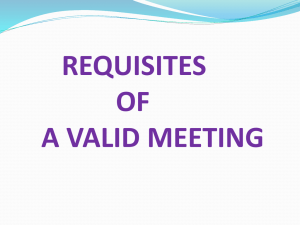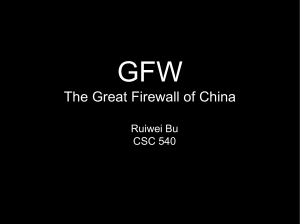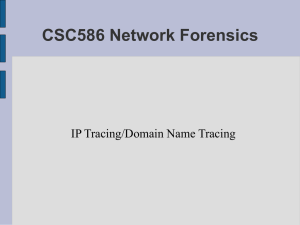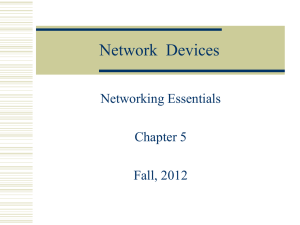Aglet
advertisement
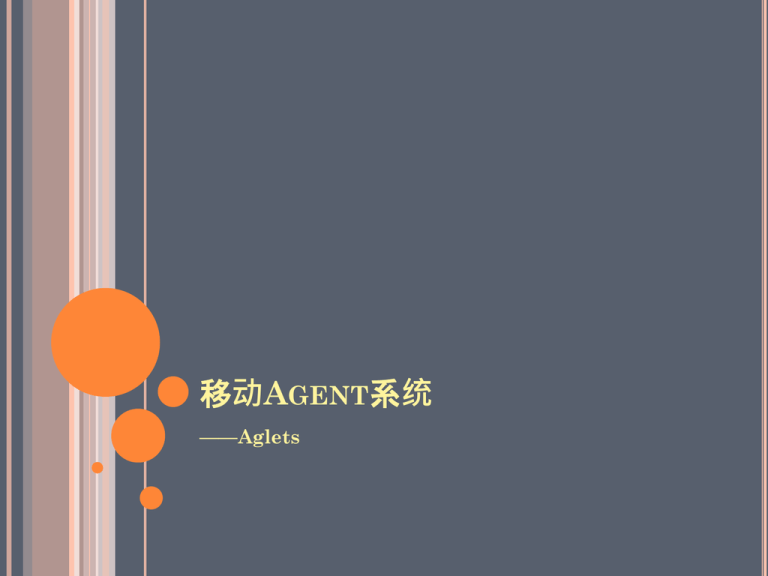
移动AGENT系统
——Aglets
提纲
Aglets简介
Aglets模型
Aglets API
Aglets样例
2
AGLETS
Aglets
IBM
http://www.trl.ibm.com/aglets/
http://aglets.sourceforge.net/
Latest version
2.5-alpha
Stable version: 2.0.2
3
AGLETS
What are mobile agents?
Mobile network agents are programs that can be
dispatched from one computer and transported to a
remote computer for execution. Arriving at the
remote computer, they present their credentials and
obtain access to local services and data. The remote
computer may also serve as a broker by bringing
together agents with similar interests and compatible
goals, thus providing a meeting place at which agents
can interact.
4
AGLETS
What is the Aglets Software Development Kit?
The Aglets Software Development Kit is an
environment for programming mobile Internet agents
in Java. (It is what we used to be called Aglets
Workbench.)
5
AGLETS
What is an aglet?
The aglet represents the next leap forward in the
evolution of executable content on the Internet,
introducing program code that can be transported
along with state information. Aglets are Java objects
that can move from one host on the Internet to
another. That is, an aglet that executes on one host
can suddenly halt execution, dispatch itself to a
remote host, and resume execution there. When the
aglet moves, it takes along its program code as well
as its data.
6
AGLETS
Aglet Mobile Agent Platform (Aglets MAP): is the
core platform, able to manage mobile agents.
Tahiti: is the main server in charge of managing
the mobility of agents. It comes with a GUI that
helps administrators taking care of running
agents.
Aglets Software Development Kit (Aglets SDK –
ASDK): is a library that provides developers all
the facilities required to write mobile agents
compliant to the Aglets MAP.
7
AGLETS
迁移机制
通信机制
安全保障
8
MOBILITY
Strong Mobility vs. Weak Mobility
Example
for (int i = 0; i<10; i++){
migrate ( remoteHosts[i] );
}
9
MOBILITY
Aglets only support weak mobility!
In fact, almost all the Java MAP support only the
weak mobility.
No support in Java to get enough information about
the execution flow.
The Thread class itself is not serializable, and so
cannot be transmitted over the network.
10
MOBILITY
Aglets ensures that an agent will keep its Java
state (i.e. the value of its inner variable) among
migrations (at least if the Java state is
serializable).
When the agent is going to be executed on the
remote machine, the execution will start from a
well defined entry point (a method), and no reinitialization will happen (in order to not override
the current agent state).
11
COMMUNICATION
Based on message passing!
Agents cannot directly reference other agents, so
it is not possible for an agent to handle a “pointer”
to another agent.
For security reason
12
COMMUNICATION
Proxy Pattern
A proxy is an object that masquerades another object
(its owner) and that forwarders method calls to its
owner.
13
COMMUNICATION
Aglets are hidden by proxies, and other aglets
can send messages or perform method calls
against the proxy, having the proxy to forward
such method calls on the owner agent.
Advantages:
Aglets are always protected, being invisible and that
the system can create and manage a lot of proxies for
the same aglet without breaking the agent protection.
The dispose of a proxy does not causes the disposing
of the agent it is masquerading.
In Aglets, agents are created and managed by the
MAP, while proxies represents “handles” to other
agents, thanks to which agents can communicate
each other.
14
SECURITY
protection of the host against aglets,
protection of other aglets,
protection of the aglet from the host, and
protection of the underlying network.
15
SECURITY
16
SECURITY
The Aglet security model supports the flexible
definition of various security policies and
describes how and where a secure system
enforces these policies.
Security policies are defined in terms of a set of
rules by one administrative authority.
17
SECURITY POLICIES
the conditions under which aglets may access
objects;
the authentication required of users and other
principals, which actions an authenticated entity
is allowed to perform, and whether entities can
delegate their rights;
the communications security required between
aglets and between contexts, including trust; and
the degree of accountability required for each
security relevant activity.
18
AGLET 体系结构
Generic
Mobile
Agent
Server
Interagent
Communication
Manager
Agent
Manager
Network
Generic
Mobile
Agent
Server
Agent
Reliability
Manager
Generic Mobile Agent Server
Application
Gateway
External
Application
Directory
Manager
Security
Manager
19
AGLET 模型
What
is java aglet?
Lightweight agent
Java object that can move from one host to
another
A mobile java agent that supports concepts of
autonomous execution and dynamic routing on its
itinerary.
Has its own thread of control
Is event-driven
Communicates by message passing
“Write once, go anywhere”
20
AGLET MODEL(1)
Basic
Elements:
Aglet – a mobile Java object
Proxy – a representative of an aglet
Context – an aglet’s workplace
Identifier – bound to each aglet
21
RELATIONSHIP BETWEEN AGLET AND
PROXY
Proxy Represents the Aglet
A handle for local, remote or deactivated aglet
Shields Public Methods for Potential Misuse
Can Hide the “actual” Location of Aglet
Proxy and Aglet on Different Computing Nodes
Proxy :Aglet < = > n : 1
22
Clients
Interaction
Proxy
Aglet
H1
Clients
Interaction
Proxy
H2
Aglet
23
CONTEXT
A
context is an uniform execution environment for
aglet.
a stationary object
provides a means for maintaining and managing
running aglets
One
node in a computer network may run
multiple servers and each server may host
multiple contexts.
Contexts are named and can thus be located by
the combination of their server's address and their
name.
24
CONTEXT
Aglets must be instantiated within a context, and at any
time belong to exactly one context.
Context can be used for:
createAglet
retractAglet
getAgletProxies / getAgletProxy
setProperty/getProperty
25
RELATIONSHIP BETWEEN HOST,
SERVER PROCESS(ENGINE), AND
CONTEXTS
Host
Context
Context
Context
Server Process (Engine)
26
Network
CONTEXT, PROXY, AGLET
aglet Proxy
Context
27
AGLET MODEL(2)
Basic Elements
Aglet : a mobile java object
Proxy : a representative of an aglet
Context : an aglet’s workplace
Identifier : bound to each aglet
Message : an object exchanged between aglets
Future reply : an asynchronous message-sending
28
AGLET MODEL(2)
Message
an object exchanged between aglets. It allows for
synchronous as well as asynchronous message
passing between aglets.
Future
reply
A future reply is used in asynchronous messagesending as a handler to receive a result later
asynchronously
29
AGLET : COMMUNICATION MODEL
Message
passing:
Allows aglets to create and exchange messages
in flexible ways.
Key Components:
Aglet, AgletProxy, Message, Future reply, Reply set
Aglet/
Application
Message
Reply
Proxy
Message
Aglet
Reply
30
AGLET MODEL(2)
Message
aglet
Proxy
Proxy
aglet
Context
31
AGLET: OPERATIONS
Six Basic Operations
1.
2.
3.
4.
5.
6.
Creation
Cloning
Dispatching
Retraction
Activation and Deactivation
Disposal
32
AGLET: OPERATIONS
Creation
Initializes a New Aglet
Assigns Aglet an Identifier
Cloning
Produce an Identical Copy of an Aglet
Differences Between Clone and Original Aglet
Identifier
Place of Execution
33
AGLET: OPERATIONS
Dispatching
Aglet is Transported (Pushed) From One
Context to Another
Retraction
Concept that Returns an Aglet Back to its
Original Context
Original Context Pulls Back the Aglet From
the Current Context
34
AGLET: OPERATIONS
Deactivation and Activation
Deactivation Must Occur Before Activation
Deactivation Halts the Execution of an Aglet
Activation Starts Execution of an Aglet
Activation Must Occur to Restore the Aglet
Disposal
Stops Execution of an Aglet
Removes an Aglet From its Current Context
35
BASIC OPERATIONS
Classification
Classified as the Life Cycle of an Aglet
Observation
of Six Basic Aglet Operations
of Six Basic Aglet Operations
Context Functions Just Like a Place
36
AGENT LIFE-CYCLE MODEL
Context A
Clone
Context B
Dispatch
Aglet
Aglet
Dispose
Retract
Create
Class
File
Deactivate
Activate
Disk
Storage
37
AGENT LIFE-CYCLE MODEL
38
AGLET EVENT MODEL
Aglet Programming Model
Similar to the Java Event Model
Event Based
Listeners Used to Perform Event Actions
Three Event Model Listeners
Clone Listener
Mobility Listener
Persistence Listener
Actions
Listen for the Event They are Named After
Listeners Can Be Customized to Perform Specific
Actions When the Listener Event Occurs
39
RELATIONSHIP BETWEEN AGLET AND ITS
LISTENERS
Aglet
Clone Events
CloneListener
Mobility Events
MobilityListener
Persistence Events
PersistenceListener
40
EVENT MODEL LISTENERS
Clone Listener
Listens for Cloning Events
Actions Can Be Customized to Occur Before, During,
or After the Cloning
Mobility Listener
Listens for Mobility Events
Actions Can Be Customized to Occur When an Aglet
is About to Be Dispatched, Retracted, or Arrives in a
New Context
Persistence Listener
Listens for Persistence Events
Actions Can Be Customized to Occur When an Aglet
is About to Be Deactivated or Has Been Activated
41
EXAMPLE
Agent dispatch
42
THE AGLET MODEL
Message Handling
Aglets exploit a communication system based on
message passing.
An agent that wants to explicitly manage messages
has to override the handleMessage(..) method,
returning true in the case that the message is
managed by the agent, and false otherwise.
43
MESSAGE HANDLING
An aglet is not necessarily aware of message
source, it just receives and handles messages.
Message source should be included in some way
in the message itself, since there is no other way
to identify it.
Message handling is as complex as the
handleMessage(…) implementation.
The method handleMessage(Message msg) has
one parameter, the message received by the
aglet, which can be used to define the aglet
message handling behavior.
The message type is its classification.
44
MESSAGE HANDLING
45
THE AGLET MODEL
Agent Design Patterns
Traveling
Task
Interaction
46
AGENT DESIGN PATTERN (CONT.)
Traveling
Itinerary: routes among destinations.
Forwarding: a host forwards an arrived agent to another
host.
Ticket: objectifies a destination address and
encapsulates the quality of service and permissions
needed to dispatch an agent to a host address and to
execute it there.
47
AGENT DESIGN PATTERN (CONT.)
Task
Master-Slave: an agent delegate a task to another
Plan: organize multiple tasks to be performed in
sequence or in parallel by multiple agents.
48
AGENT DESIGN PATTERN (CONT.)
Interaction
Meeting: two or more agents initiate local interaction at
a given host.
Locker: defines a storage and come back for data later.
Messenger: an agent carries a remote message from one
agent to another.
Facilitator: an agent provides services for naming and
locating agents.
Organized Group: travel together.
49
Aglet Class & API
50
AGLETS
Mobile
Agents with Java
Aglet Package (Classes)
Aglet Class
Message Class
AgletID Class
AgletInfo Class
AgletStub Class
FutureReply Class
QoC Class
ReplySet Class
51
AGLETS
Mobile
Agents with Java
Aglet Package (Interfaces)
AgletProxy Interface
AgletContext Interface
MessageManager Interface
52
AGLET API: CLASSES
Aglet
Class
Contains All Methods Needed to Perform the
Basic Aglet Operations
Basis for Building All Aglets
Contains All the Elements of the Aglet
53
AGLET CLASS
Aglet Creation
Create a Customized Aglet
import com.ibm.aglet.*;
public class MyFirstAglet extends
Aglet{
//Put aglet’s methods here
}
The Dispatch Method
Dispatches an Aglet to a Remote Context
The Method Call Contains the URL of the Remote
Context
dispatch(new
URL(atp://remote.host.com/context”));
54
AGLET CLASS
Overridden methods:
public void onCreation(Object init){
//do some initialization here…
}
public void run() {
//do something here;
} //main entry point e.g. call dispatch(new
URL(“atp://some.host.com//context”));
55
AGLET API :AGLET
CLASS
What happens when “dispatch”?
Object Serialization
Transfer
State
Byte Code
Host
Sending
Deserialization and
re-create state
Host
Host
Receiving
State
Byte Code
Host
56
MESSAGE CLASS
Message Objects are Sent Using the AgletProxy
Class Methods
Object sendMessage(Message msg)
void sendOnewayMessage(Message msg)
Code Example
proxy.sendMessage(myName);
String name =
(String)proxy.sendMessage(yourName)
;
57
MESSAGE CLASS
handleMessage method:
Public boolean handleMessage(Message msg){
if(msg.samekind(“my name”)){
String name=(String)msg.getArg();
return true; //Yes, I handled this message
} else if(msg.samekind(“your name?”)) {
msg.sendReply(“Yina”); //Return its name
return true; //Yes, I handled this message
} else
return false;
//No, I did not handle this message
}
58
AGLET API : AGLETPROXY
How
to get a proxy?
Get proxy from a newly created aglet:
AgletContext.createAglet()
AgletProxy.clone()
Get proxy from existing aglets
Aglet.getProxy() – get its own proxy
AgletContext.getAgletProxies() – retrieve an enum. of proxies in a
context
AgletContext.getAgletProxy() – get an aglet proxy for a given
aglet ID
AgletContext.setProperty – put proxy into context property and
share it.
59
AGLET API : AGLETCONTEXT
An
aglet context is the equivalent of a
place.
An aglet uses AgletContext interface to:
Get information about its environment
Send message to the environment, including
other aglets currently active in that
environment
How
it works:
context=getAgletContext();
context.createAglet();
context.retractAglet(remoteContextURL,agletID);
60
EXAMPLE
•
Aglet Example: Remote File Update
•
Premise: Large Multiple Remote Files that Must be
Updated by Word Replacement
One Solution: Move Files to Central Server, Perform
Update, and Move Files Back
Another Solution: An Aglet that Updates Files by
Replacing All Occurrences of One Specified Word in the
Files With Another Specified Word
Distributes the Load of Updates to Multiple Servers
•
We’re Moving “Code” Rather Than Files
•
•
•
61
MULTIPLE AGLETS UPDATING FILES IN
PARALLEL
Host
Host
F
Aglet
F
F
F
Aglet
Host
F
F
Aglet
Aglet
Host (Updating)
62
UPDATE FILE AGLET
import
import
import
import
public
com.ibm.aglet.*;
com.ibm.aglet.event.*;
java.net.*;
java.io.*;
class UpdateFile extends Aglet{
URL destination = null;
File dir = null;
String from = null;
String to = null;
public void onCreation(Object args){
destination = (URL)((Object[])args)[0];
dir = (File)((Object[])args)[1];
from = (String)((Object[])args)[2];
to = (String)((Object[])args)[3];
addMobilityListener(){
new MobilityAdapter(){
63
UPDATE FILE AGLET
Public void onArrival(MobilityEvent e){
replace(args.file,args.from,args.to);
dispose(); }
}
}
try{
dispatch(args.destination);
}catch (Exception e){
System.out.println(“Failed to dispatch.”);
}
}
void replace(File, file, String, from, Sting
to){
//Open ‘file’ and replace ‘from’ with ‘to’
}
64
APPLICATION OF AGLETS
Marketplace Architecture
Shop agents go to a market from a shop owner’s terminal
Customer agents travel around various markets to get more
information
Market advertisers go to other markets to invite customer agents
65
ANATOMY OF AN AGLET
Creation & Disposal
Clone
Mobility
– Dispatch and Retract
Persistence
– Activate and Deactive
66
CREATION
public final AgletContext Aglet.getAgletContext()
//Example:
getAgletContext().createAglet(getCodeBase(),”SomeAglet”,null);
Methods that can be overridden
protected Aglet.Aglet()
Public void Aglet.onCreation(Object init)
Public void Aglet.run()
createAglet()
Aglet()
onCreation
run()
67
CLONING
public final Object Aglet.clone()
public final void Aglet.addCloneListener(CloneListener
listener)
public final void
Aglet.removeCloneListener(CloneListener listener)
public CloneAdapter.CloneAdapter()
public void CloneAdapter.onCloning(CloneEvent event)
public void CloneAdapter.onClone(CloneEvent event)
public void CloneAdapter.onCloned(CloneEvent event)
68
CLONING
public class CloningExample extends Aglet{
boolean _theClone=false;
public void onCreation(Object o) {
addCloneListener(new CloneAdapter(){
public void onCloning(CloneEvent e){
// print to the console }
public void onClone(CloneEvent e){
// print to the console }
public void onCloned(CloneEvent e){
// print to the console }
} );
}
run()
onCloning()
onCloned()
onClone()
run()
public void run() {
if (! _theClone) {
//the original runs here…
try{
clone();
} catch (Exception e)
{ System.out.println(e.getMessage(
));
}
else {//the clone runs here…}
}
original
clone
69
MOBILITY
-- Dispatching
run( )
dispatch( )
onDispatching( )
onArrival( )
run( )
Origin
Destination
-- Retracting
retractAglet( )
onArrival( )
run( )
run( )
onReverting( )
Local
Remote
70
PERSISTENCE
Persistence
Aglet Context
Activate
Deactivate
run( )
deactivate( )
onDeactivating( )
onActivation( )
run( )
Before
After
71


